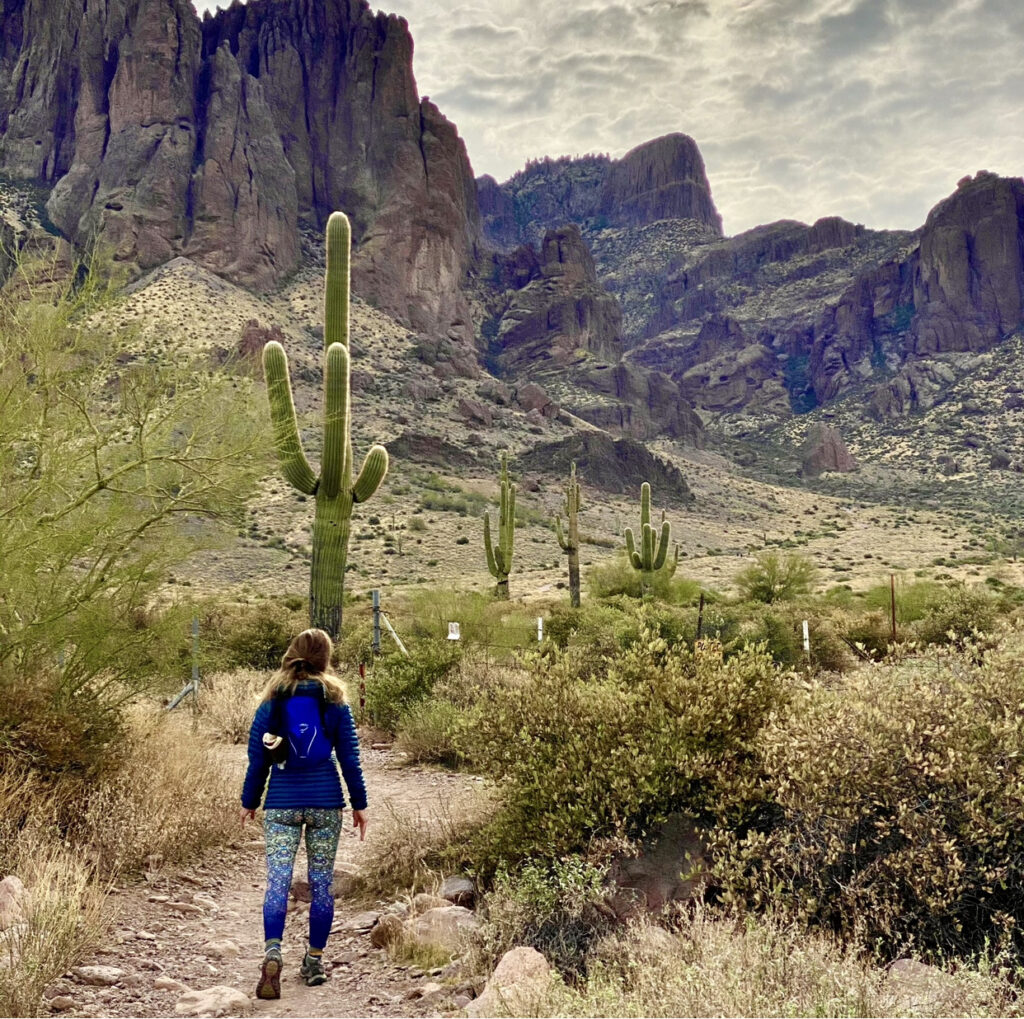Oren Arnold, American journalist and novelist once said, “Don’t let the truth stand in the way of a good story.”
The Old West, about which Arnold penned 80 books, is like a mother-lode of tantalizing tales, folk lore and legends. Perhaps the most intriguing Western tale perpetuated through the generations is the Legend of the Lost Dutchman’s Gold Mine.
The story takes place more than a century ago in Central Arizona’s Tonto National Forest within the 160,000 acres of brutal Arizona desert known as the Superstition Mountains. The ‘Supes’ as they are referred by AZ locals, are aptly named. Home to popular myths, strange mysteries and mystical phenomena, many remain unexplained. Its history dates back 9,000 years. Long before the American Frontiersmen, mountain men, prospectors and cowboys came in search of pelts and gold, these mountains were home to the Apache Indians. The Apaches considered the highest peak to be sacred ground and home to their Thunder God. In the late sixteenth century Spanish Conquistadors from the Mexico arrived in search of gold. Rumors had circulated that “Seven Cities of Cibola” (Gold) were located hundreds of miles to the north scattered across the desert. Determined to find gold, the Spaniards in their insatiable quest for riches showed complete and utter disregard for the Apaches’ beliefs. This led to the Natives’ claim that their God of Thunder would seek revenge upon the explorers. Seemingly, revenge befell them. As the explorers began to disappear one by one, their bodies were turning up lifeless. The Conquistadors fled the mountains in haste. Upon their departure they named the highest mountain along the ridge-line ‘Monte Superstition’.
The Legend of Jacob Waltz
Merriam-Webster Dictionary provides 2 distinct definitions for the word Legend. The first definition is:
a story from the past that is believed by many people but cannot be proved to be true.
This is the story of the Lost Dutchman’s Gold Mine.
Jacob Waltz was a German immigrant who arrived in the USA in 1839. A prospector for gold, he professed to have found the location of the world’s richest gold mine hidden somewhere within the Superstition Mountains. Documents show that Waltz lived in the Territory of Arizona between 1863-1891 traveling between his home in Phoenix and an undisclosed location in the Eastern Mountains. Upon his deathbed, Waltz was said to have made a confession to his acquaintance Julia Thomas which provided clues to the location of the gold mine. Thomas’s own search for the gold upon old Jake’s passing proved unsuccessful. She capitalized on the opportunity by printing and selling crude hand drawn treasure maps containing details of the final ramblings of Jacob Waltz.
Long before the first tourist set foot in Arizona, the story of the Lost Dutchman’s Gold Mine became a part of pioneer history. A story rooted in misinformation, fraudulent maps and wild imagination is the basis by which millions of dollars have been lost to unscrupulous promotors by avaricious investors. With the promise of a stash worth a couple million dollars in modern day valuation, it has lured thousands of treasure hunters eager to decipher the Dutchman’s clues and riddles leading to the secret location within the mountains. Since 1891 there have been over 130 unsubstantiated claims of finding the gold. More surprisingly there have been just as many deaths (with some estimates being as high as 600) associated with treasure seekers in the cursed mountains. In more recent years, a Colorado man’s body was discovered 3 years after he set out to find the lost gold. That finding came on the heels of the discovery of the remains of 3 Utah men also on a quest to find the Lost Dutchman’s Mine. Are these mountains cursed? Many believe so.
To this day Jacob Waltz’s gold mine remains a mystery. Like any great legend and without any real proof, we want to believe the story and hope that one day some lucky seeker will find their fortune. But while we sit and ponder the story’s validity, I will share with you another Legend of the Superstition Mountains which is no myth. It is a fact, based 100% in truth.
The Legend of Jim Greentree
The Merriam- Webster dictionary’s second definition of the word Legend is:
a famous or important person who is known for doing something extremely well.
This is the story of a man known to many hikers in the Superstition Mountains as FlatIron Jim.
Located within the Lost Dutchman’s State Park (yes, Jacob Waltz has a park named after him) is the trailhead to the Siphon Draw Trail. Known as one of the top 10 hikes in the state of AZ, it is both epic and dangerous as it leads you on a climb towards the towering cliffs overlooking the rugged Superstition Mountain range. Just over 6 miles in length, gaining 2745 feet of elevation up to a prominent protruding rock formation known as the FlatIron, the hike is unforgiving especially in the heat of the summer sun. According to one Arizona Park Ranger, “It’s the hardest hike in the Valley. Once you get past the basin area there’s no designated trail. It’s a five to eight-hour hike for avid hikers and your last mile is pretty much a vertical climb over rocks and boulders 2 to 10 feet tall.” I can attest to this statement! It is no joke and definitely not a hike to be undertaken by the unprepared. The day I hiked Flatiron, I witnessed THREE helicopter rescues within the span of 5 hours, later providing my video footage to the rangers upon request. In 2019, a group of 44 hikers from Kansas were rescued off of the trail in one night! Many hikers are not so lucky and meet their demise right there on the mountain. Most recently just after midnight on January 24, 2022, a young hiker fell to his death from the top of Flatiron.
On that same day that I personally conquered the mountain, I had the unique opportunity to meet a true Legend of the Superstitions Mountains. Jim Greentree, born in British Columbia in 1931, turned 90 in June of 2021. He has hiked the Flatiron over 300 times in the past decade according to his own estimation. There seems to be no stopping him as he successfully completes this challenge multiple times a week. An inspiration to anyone who is lucky enough to encounter him on the trail, he is always happy to snap a photo with you and tell his story. It was an honor and a pleasure to meet him. Deserving as he is, currently a park in his name does not appear to be in the works. Great legends live on and I’m happy to do my part to keep the Legend of FlatIron Jim alive.
If Oren Arnold were alive today he’d say that Jim’s story is a good one and it is a story where truth doesn’t stand in the way- it leads the way!








